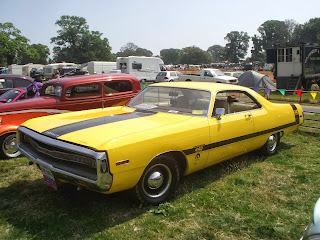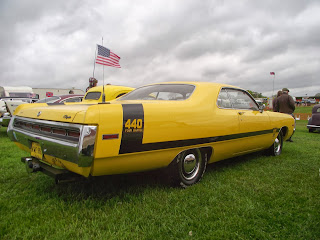Vintage Thing no.131 - Chrysler 300
By way of a break from Impish little cars, here's something from the other extreme of Chrysler's automobile range, the 1970 Chrysler 300.
The Chrysler 300 non-letter cars traded on the performance image of Chrysler's letter series 300s. These started in 1955 with the C-300 and finished up with the 1965 300L but the less sporty 300 non-letter range sidled up to join the letter range 300s in 1962 and promptly outsold it.
Being cheaper helped in the sales war but I can't help thinking that some people may have bought a 300 by mistake when they really thought they were getting a 300H. Enthusiasts claim that the new non-letter 300devalued the 300H and marked the latter out as a specialist performance automobile.
I say, what's wrong with that? But the marketing men seem to have known what they were doing, I'm sorry to say. Sales of the lower-spec 300 non-letter cars were always greater and they outlived the letter cars by six years, those same six years where the muscle car was at its zenith.
But the 300 - either with a letter or without one - was no muscle car. It was firmly in the prestige category, the one which demands that your purchase impresses others.
I've often admired American cars for their style and performance but wondered what size I'd be happy with. A Jag Mk10 is probably as big a car as I would actually like to own and with this Chrysler 300 I think I've found my limit.
The front and rear overhangs impress and appall me. There is simply no need and in packaging terms it's a disaster, especially in 2 door form. But it's undoubtedly sleek and low. It's the sheer decadence that I like. Other American prestige cars might match the Chrysler 300 for size but they can't approach it for grace.
It's the car the The B52s sang about in Love Shack.
Even though it's Mopar and not GM, it meets Harley Earle's edict that every time a driver takes the wheel he goes on a little holiday.
And it's not a camping holiday, either.
This bodyshell was introduced for the 1969 model year and it lasted until 1971 when the 300 party was over. Chrysler called it "fuselage" styling and there is something of a Jumbo jet about it. I much prefer it to the "Manhattan skyline" approach to radiator grilles and stacked lights that blighted American cars from the 70s onwards.
Nothing could really follow the 1971 Chrysler 300 so nothing did until 2003, apart from a slight twitch of the corpse in 1979 but that Chrysler 300 was a pale shadow and only had 360 cubes. Current ones are fuel efficient and can be as small as a 2.7 litre V6.
The dimensions of the 1970 Chrysler 300 are simply worth stating - length is 571 cm, width is 201cm and height 141cm. But the Chrysler 300 is not about height - it's all about length and width. For people viewing in black and white, the Chrysler 300 is 18 feet 9 inches long and 6 feet 7 inches wide. Yet it's only two inches taller than a Hillman Imp.
Comparison with a Jag Mk10 are interesting. At 6' 6", it was the widest British production car, beaten only by the Jaguar XJ220 (unless someone else knows any better) at 6' 7½". The Mk10 was 5.1 metres long or 16 feet 10 inches.
Although not powered by a Hemi, this has the 440 CID or 7206cc V8,
the one celebrated in certain non-soundtrack recordings by The Blues
Brothers. Bore was 109.7mm, stroke was 95.25mm. At 480 lb ft (651nm) torque was more than adequate. Hemis had been for the letter cars from the start although they were of smaller displacement and replaced in the 1960 300F by a 413 CID ram induction wedge head motor. The 440 engine in the 300 put out at least 335bhp (250kW) and in the delightfully named 440 TNT set up gave 375bhp with a 4 barrel - or choke - carburettor.
But it's the brakes that ultimately put me off the Chrysler 300. Like many American cars of the era, they were just big drums. Servo assistance was optional if not advisable. A 1970 Chrysler 300 weighs 1960kg and needs good brakes to haul it down from the legal limit, let alone its 120 mph maximum speed. Discs were available on less sporty Chrysler behemoths from 1972 onwards but I'm not sure the stock tyres would be up to much, either, and as for sports car handling...
But agility on the road wasn't something the Chrysler 300 ever aspired to.
It's the kind of car Gerry Anderson and Derek Meddings saw us driving in the near future when science and technology was our friend and not to be feared. It's got dream car glamour and no sense of impending fuel crisis doom.
I can see it in that car stacker in The Thunderbirds episode entitled Move and you're Dead in which Alan Tracy goes road racing.
Chrysler resurrected the 300 in 2003 and for me it's one of the more saloons so far this century. Some have Hemis but all are automatics so there the appeal begins to fade.
When I drive an automatic, it reminds me of the only time I rode a horse.It felt like it had a mind of its own, didn't hold the road well and was unpredictable. When I drive an automatic part of me is waiting to be scraped off against a tree or a wall.
At least modern Chrysler 300s have disc brakes.
 |
| A car this size has presence. It turned up at the Launceston show |
The Chrysler 300 non-letter cars traded on the performance image of Chrysler's letter series 300s. These started in 1955 with the C-300 and finished up with the 1965 300L but the less sporty 300 non-letter range sidled up to join the letter range 300s in 1962 and promptly outsold it.
Being cheaper helped in the sales war but I can't help thinking that some people may have bought a 300 by mistake when they really thought they were getting a 300H. Enthusiasts claim that the new non-letter 300devalued the 300H and marked the latter out as a specialist performance automobile.
I say, what's wrong with that? But the marketing men seem to have known what they were doing, I'm sorry to say. Sales of the lower-spec 300 non-letter cars were always greater and they outlived the letter cars by six years, those same six years where the muscle car was at its zenith.
But the 300 - either with a letter or without one - was no muscle car. It was firmly in the prestige category, the one which demands that your purchase impresses others.
I've often admired American cars for their style and performance but wondered what size I'd be happy with. A Jag Mk10 is probably as big a car as I would actually like to own and with this Chrysler 300 I think I've found my limit.
The front and rear overhangs impress and appall me. There is simply no need and in packaging terms it's a disaster, especially in 2 door form. But it's undoubtedly sleek and low. It's the sheer decadence that I like. Other American prestige cars might match the Chrysler 300 for size but they can't approach it for grace.
It's the car the The B52s sang about in Love Shack.
Even though it's Mopar and not GM, it meets Harley Earle's edict that every time a driver takes the wheel he goes on a little holiday.
And it's not a camping holiday, either.
This bodyshell was introduced for the 1969 model year and it lasted until 1971 when the 300 party was over. Chrysler called it "fuselage" styling and there is something of a Jumbo jet about it. I much prefer it to the "Manhattan skyline" approach to radiator grilles and stacked lights that blighted American cars from the 70s onwards.
Nothing could really follow the 1971 Chrysler 300 so nothing did until 2003, apart from a slight twitch of the corpse in 1979 but that Chrysler 300 was a pale shadow and only had 360 cubes. Current ones are fuel efficient and can be as small as a 2.7 litre V6.
The dimensions of the 1970 Chrysler 300 are simply worth stating - length is 571 cm, width is 201cm and height 141cm. But the Chrysler 300 is not about height - it's all about length and width. For people viewing in black and white, the Chrysler 300 is 18 feet 9 inches long and 6 feet 7 inches wide. Yet it's only two inches taller than a Hillman Imp.
Comparison with a Jag Mk10 are interesting. At 6' 6", it was the widest British production car, beaten only by the Jaguar XJ220 (unless someone else knows any better) at 6' 7½". The Mk10 was 5.1 metres long or 16 feet 10 inches.
 |
| Try that trick with your thumb again, this time blanking off portions of the front overhang |
 |
| The interior is a bit of a let down. It's got furry dice though. This particular car could have been yours this summer for £9995. |
But agility on the road wasn't something the Chrysler 300 ever aspired to.
It's the kind of car Gerry Anderson and Derek Meddings saw us driving in the near future when science and technology was our friend and not to be feared. It's got dream car glamour and no sense of impending fuel crisis doom.
I can see it in that car stacker in The Thunderbirds episode entitled Move and you're Dead in which Alan Tracy goes road racing.
 |
| You're doing that thumb over the rear thing again now, aren't you? |
When I drive an automatic, it reminds me of the only time I rode a horse.It felt like it had a mind of its own, didn't hold the road well and was unpredictable. When I drive an automatic part of me is waiting to be scraped off against a tree or a wall.
At least modern Chrysler 300s have disc brakes.





Comments
Post a Comment